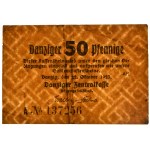An October-dated, A-series variety with NO double underlined.
In our opinion, this is one of the most undervalued banknotes of the Free City of Danzig.
A rare denomination, the frequency of which can be safely compared to 2 guilders. Many times rarer than other pfennigs, especially those with an October date.
Tape mark on the reverse.
A circulating but natural piece, with correct presentation.
The Free City of Danzig was established in November 1920 under the agreements of the Treaty of Versailles. The issue of the currency system was left to the decisions of the city authorities. Initially, the German mark was maintained in the area. However, as a result of rampant inflation in Germany, it was decided to establish its own currency - the guilder, which was divided into 100 fenigs. It became legal tender in late 1923 and remained until 1939. The paper money issued in Danzig featured the city's iconography.
On November 20, 1923, changing the currency from the mark to the guilder set the exchange rate at 1 guilder = 750 billion marks. As the decision to change the currency was made on November 6, 1923, there was not enough time to prepare coins and banknotes. Initially, the Danzig banks established a temporary issuing institution, the Danzig Central Bank, which was to operate until March 31, 1924. It issued one-sided temporary paper money in denominations: 1, 2, 5, 10, 25 and 50 fenges and 1, 2, 5, 10, 25, 50 and 100 guilders. The money was a means of payment until April 30, 1924. After that date, they were exchanged for Bank of Danzig (Bank von Danzig) money for six months. The first guilder bills of the new Danzig issuing institution appeared in circulation in mid-March 1924. They all have the same style. Their design included the great coat of arms of the city, elements of city architecture and sculptural detail. All the guilder banknotes were printed at the British securities printer Bradbury, Wilkinson & Co. Ltd, New Malden, Surrey.










